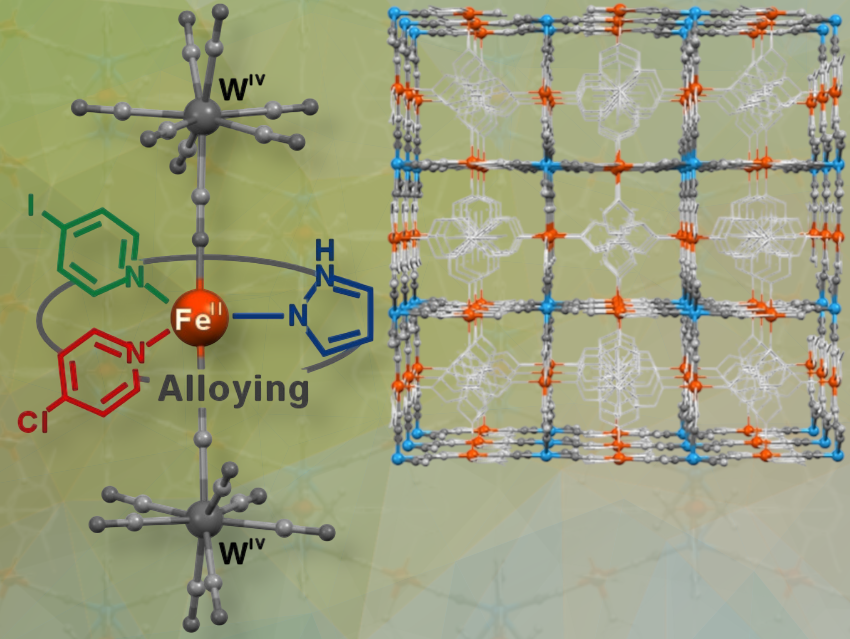Junhao Wang and Hiroko Tokoro, University of Tsukuba, Japan, discuss the recently published findings by them and other colleagues, showing how molecular alloying with small ligands enables the design of multifunctional magnetic materials, and how this work was inspired by a conference visit.
What did you focus on in your recent EurJIC paper?
Our research team works on designing and studying materials that respond to external triggers like temperature, light, or magnetic fields. These materials have exciting potential for applications in areas like memory storage, sensors, and advanced technologies such as quantum computing. A key focus of our work is spin crossover (SCO) materials, which can switch between different magnetic states, offering a unique way to control their properties for practical use.
In this study, we explored how combining three small organic molecules—4-chloropyridine, 4-iodopyridine, and pyrazole—within a 3D molecular framework could influence the material’s behavior.
We created a crystal where these molecules were randomly mixed around the iron (Fe) atoms, a process called molecular alloying. This approach allowed us to investigate how the mix of molecules affected the material’s magnetic and optical properties.
What did you find?
Our findings were twofold: first, the material displayed a gradual magnetic state change with temperature; second, its special crystal structure enabled it to double the frequency of incoming light, a property known as second-harmonic generation.
By combining these effects in one material, we showed how tailoring molecular interactions can create multifunctional materials, pushing the boundaries of what these systems can achieve.
What motivated you to pursue this research?
Tuning the SCO behavior to achieve specific functionalities remains a challenge. By investigating molecular alloying using small, monodentate ligands, we aim to systematically explore how ligand diversity and arrangement affect SCO properties and cooperativity between spin centers.
This approach not only provides fundamental insights into material design but also paves the way for creating multifunctional materials with tailored magnetic and optical responses.
What is new and cool about your research?
This research is the first to successfully alloy three different small monodentate ligands within a single, stable crystalline phase using a cyanido-bridged 3D coordination framework. The resulting material showcases two features: (1) gradual spin crossover behavior driven by the unique ligand arrangement, and (2) second-harmonic generation due to the non-centrosymmetric crystal structure.
The combination of SCO and nonlinear optical properties in a single material highlights the potential for multifunctionality, which is rare in this field and highly valuable for advanced applications.
What is the longer-term vision for your research?
This research opens up exciting possibilities for multifunctional materials with both magnetic and optical properties.
The gradual spin crossover behavior makes the material suitable for applications in memory storage, temperature sensors, and actuators, where precise control over magnetic states is essential. Meanwhile, the second-harmonic generation (SHG) property positions it as a potential candidate for advanced optical devices, such as frequency converters and photonic systems.
The longer-term vision is to leverage molecular alloying as a versatile tool to design materials with customizable properties. By fine-tuning the ligand composition and arrangement, we aim to achieve better control over magnetic interactions, optical responses, and cooperative phenomena. Our ultimate goal is to bridge fundamental discoveries with practical applications that address emerging technological challenges.
What part of your work was the most challenging?
The most challenging part of our study was the structural characterization of the molecular alloyed framework.
Initially, we hypothesized that the three ligands—4-chloropyridine, 4-iodopyridine, and pyrazole—would occupy specific crystallographic positions based on their distinct structural affinities. However, single-crystal XRD analysis revealed an unexpected occupational disorder among the ligands, where they randomly shared the same crystallographic positions. This disorder made it impossible to precisely determine the chemical formula through crystallographic techniques alone.
To overcome this issue, we turned to halogen elemental analysis, which allowed us to accurately determine the ratio of the three ligands. This additional analytical step was essential to validate our structural model and ensure the robustness of our conclusions.
This unexpected complexity required us to rethink our approach and integrate complementary analytical techniques, ultimately reinforcing the significance and reliability of our findings.
This study highlights the potential of ligand-based molecular alloying as a powerful strategy for designing multifunctional materials with tunable properties. By successfully incorporating three distinct small ligands into a single coordination framework, we not only demonstrated the versatility of the cyanido-bridged Fe(II)–W(IV) system but also opened avenues for exploring complex cooperative behaviors in molecular materials.
What inspired your team to explore the concept of molecular alloying in your research?
Interestingly, the concept of molecular alloying was not initially part of our research framework, as it is a relatively underexplored area in the field. However, our team members, Junhao Wang and Daiki Kobayashi, attended the European Conference on Molecular Magnetism in Krakow, Poland, last year, where the Olivier Kahn International Awardee, Professor Kasper Pedersen, presented intriguing work applying molecular alloying in his research.
This conference inspired us to recognize how the concept perfectly aligns with our study. Such academic exchanges provided valuable insights, reinforcing the importance of collaborative learning.
How does your approach differ from most existing studies on molecular alloying in SCO materials?
While most molecular alloying studies in spin crossover (SCO) materials focus on polydentate analogous ligands, our exploration into the effect of small monodentate ligands represents a significant departure and broadening of this approach. We believe this direction holds great promise for uncovering novel magnetic and optical phenomena, which are critical for advancing the field of molecular magnetism.
Thank you very much for sharing these insights.
The paper they talked about:
- Molecular Alloying of Three Different Organic Ligands within a Spin-Transitional and SHG-Active FeII–WIV(CN)8 3-D Coordination Framework,
Daiki Kobayashi, Shuntaro Nagashima, Shin-ichi Ohkoshi, Junhao Wang, Hiroko Tokoro,
European Journal of Inorganic Chemistry 2024.
https://doi.org/10.1002/ejic.202400508
Junhao Wang is an Assistant Professor in the group of Professor Hiroko Tokoro at the University of Tsukuba, Japan.
Hiroko Tokoro is a Professor in the Department of Materials Science at the Institute of Pure and Applied Sciences at the University of Tsukuba, Japan.



